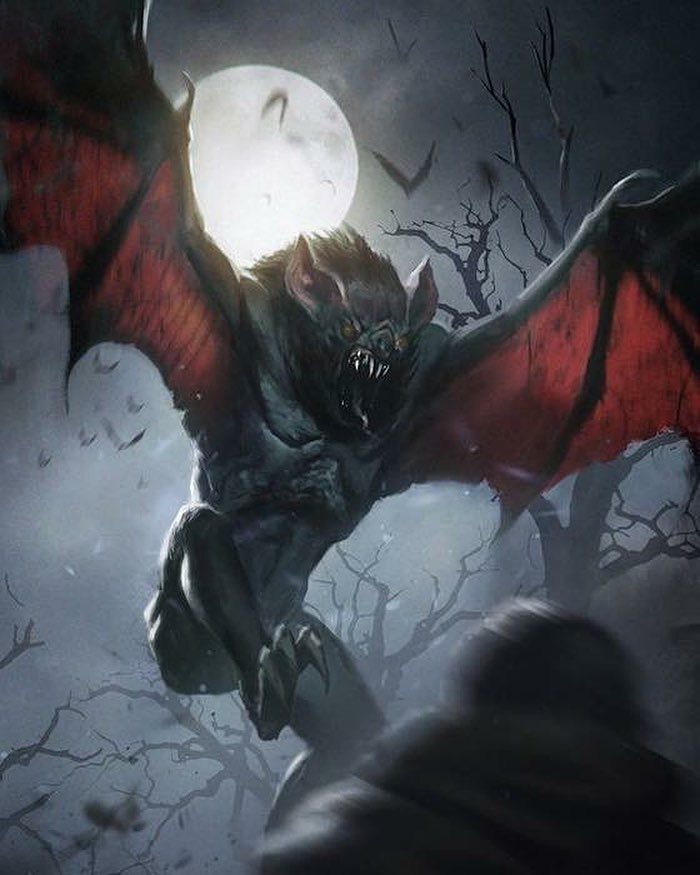Mythic Origins

Bats are regarded nearly universally in the West and across much of the world as tricksters, malevolent beings, and the servants of evil powers of night and darkness. This mythos arises from any number of sources, but most of the Werebats view their ancestor, in a spiritual if not literal sense, as the bat god Camazotz from Mayan mythology.
The Bat-God was associated with darkness, death, and ritual sacrifice. According to the myths, Camazotz was one of the guardians of Xibala, the land of the dead and the ruler of Bat House, one of the places of trial that visitors to Xibala were sent to. The powers of the Bat-God and its children were focused on death, blood, and the gathering of secrets, as well as acting as spies and messengers to the rest of the world. Camazotz traveled at night, marking those things which were destined to be destroyed and the humans who were set to die in the next day, allowing the Lords of Xibala to know who and what should die and when.
Leadership & Social Structure
Bats are found around the world, and encompass thousands of different species and subspecies, but the most infamous of them are the vampire bats which feed on blood and are limited to Central and South America where they have reputations as carriers of pestilence, plague, and of boundless hungers.
A group of Werebats is known as a Colony. Colonies are led by a pair of bats who are usually a mated couple, but it is not a requirement that they be romantically or sexually aligned with one another. The male leader of a bat colony is called the Tzotzil and the female leader is called the Tzeltal. The Werebats do not have dominance challenges like other species in order to become the leader of a Colony, but tests of combat are not unknown. Rather, Werebats rely on their intellect and wits with their challenges for rank and leadership reflecting these qualities. The winner is determined by judgment by the rest of the Colony. Some strong Werebats however, contest this practice, attaining leadership by force and keeping it through intimidation or power.
The Tzotzil and the Tzeltal are aided by the Pawatuns, four bats which take on sacred roles described in myth. Each governs one aspect of the Colony and supports the Tzotzil and Tzeltal.
- Cantzicnal - Charged with the physical security of the Colony and leads the Colony in war or battle.
- Hosanek - Charged with the material needs of the Colony, acting to provide a roost and food for the Colony.
- Hobnil - Charged with wealth and goods and ensures that the interests of the Colony have money and other goods that may be necessary to their survival.
- Saccimi - Often the least understood role within a Colony, serving as one-part assassin, one-part spy, and one-part priest/priestess.
Many Colonies also have another support role, one that is not traditionally an actual Werebat, but takes the role of the Maize God/Goddess and is a magician or healer which keeps the Colony healthy and safe.
General Traits & Abilities
One of the most successful species to live among humans and in urban environments, bats come from all cultures, regions, and peoples. Throughout history, they have performed unspoken necessities to the betterment of all, such as pollinating plants, dispersing plant seeds through their waste, eating insects which protects crops and spread of diseases, and providing guano which has been used as a main source of saltpeter, fertilizer, and anti-fungal remedy. Unfortunately, for all the benefits, bats are also carriers of many diseases that they are immune to, but can pass on to others either through direct contact or by contamination of the foods and food sources eaten by other animals and humans.
Werebats are masters of stealth and flight, able to slide through shadows and between realms with ease. They have several talents that allow them to navigate, knowing where they are, what direction is north, and what objects and peoples are in their surroundings. Their voice is a powerful offensive weapon as is their bite.
